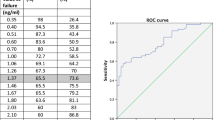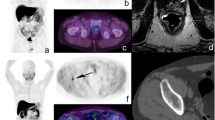Abstract
Purpose
To evaluate the accuracy of contrast-enhanced 18F-choline PET/CT in restaging patients with prostate cancer after radical prostatectomy in relation to PSA, PSA velocity (PSAve) and PSA doubling time (PSAdt).
Methods
PET/CT was performed in 49 patients (age range 58–87 years) with rising PSA (mean 4.13 ng/ml) who were divided in four groups according to PSA level: ≤1 ng/ml, 1 to ≤2 ng/ml, 2 to ≤4 ng/ml, and >4 ng/ml. PSAve and PSAdt were measured. PET and CT scans were interpreted separately and then together.
Results
PET/CT diagnosed relapse in 33 of the 49 patients (67%). The detection rates were 20%, 55%, 80% and 87% in the PSA groups ≤1, 1 to ≤2, 2 to ≤4 and >4 ng/ml, respectively. PET/CT was positive in 7 of 18 patients (38.9%) with a PSA ≤2 ng/ml, and in 26 of 31 (83.9%) with a PSA >2 ng/ml. PET/CT was positive in 7 of 25 patients (84%) with PSAdt ≤6 months, and in 12 of 24 patients (50%) with PSAdt >6 months, and was positive in 26 of 30 patients (86%) with a PSAve >2 ng/ml per year, and in 7 of 19 patients (36.8%) with PSAve ≤2 ng/ml per year. PET alone was positive in 31 of 49 patients (63.3%), and of these 31 patients, CT was negative in 14 but diagnosed bone lesions in 2 patients in whom PET alone was negative. CT with the administration of intravenous contrast medium did not provide any further information.
Conclusion
Detection rate of 18F-choline imaging is closely related to PSA and PSA kinetics. In particular, 18F-choline PET/CT is recommended in patients with PSA >2 ng/ml, PSAdt ≤6 months and PSAve >2 ng/ml per year. CT is useful for detecting bone metastases that are not 18F-choline-avid. The use of intravenous contrast agent seems unnecessary.


Similar content being viewed by others
References
Reske SN, Blumstein NM, Neumaier B, Gottfried HW, Finsterbusch F, Kocot D, et al. Imaging prostate cancer with 11C-choline PET/CT. J Nucl Med. 2006;47:1249–54.
Amling CL, Blute ML, Bergstralh EJ, Seay TM, Slezak J, Zincke H. Long-term hazard of progression after radical prostatectomy for clinically localized prostate cancer: continued risk of biochemical failure after 5 years. J Urol. 2000;164:101–5.
Rogers R, Grossfeld GD, Roach M, Shinohara K, Presti Jr JC, Carroll PR. Radiation therapy for the management of biopsy proved local recurrence after radical prostatectomy. J Urol. 1998;160:1748–53.
Schillaci O, Simonetti G. Fusion imaging in nuclear medicine – applications of dual-modality systems in oncology. Cancer Biother Radiopharm. 2004;19:1–10.
DeGrado TR, Baldwin SW, Wang S, Orr MD, Liao RP, Friedman HS, et al. Synthesis and evaluation of 18F-labeled choline analogs as oncologic PET tracers. J Nucl Med. 2001;42:1805–14.
Jana S, Blaufox MD. Nuclear medicine studies of the prostate, testes, and bladder. Semin Nucl Med. 2006;36:51–72.
Langsteger W, Beheshti M, Nader M, Stoiber F, Loidl W, Fitz F, et al. Evaluation of lymph node and bone metastases with fluor choline (FCH) PET-CT in the follow up of prostate cancer patients. Eur J Nucl Med Mol Imaging. 2006;33 Suppl 2:209.
Cimitan M, Bortolus R, Morassut S, Canzonieri V, Garbeglio A, Baresic T, et al. [(18)F]fluorocholine PET/CT imaging for the detection of recurrent prostate cancer at PSA relapse: experience in 100 consecutive patients. Eur J Nucl Med Mol Imaging. 2006;33:1387–98.
Vees H, Bucheggert F, Albrecht S, Khan H, Husarik D, Zaidi H, et al. 18F-choline and/or 11C-acetate positron emission tomography: detection of residual or progressive subclinical disease at very low prostate-specific antigen values (< 1ng/ml) after radical prostatectomy. BJU Int. 2007;99:1415–20.
Schillaci O, Calabria F, Tavolozza M, Cicciò C, Carlani M, Caracciolo CR, et al. 18F-choline PET/CT physiological distribution and pitfalls in image interpretation: experience in 80 patients with prostate cancer. Nucl Med Commun. 2010;31:39–45.
Svatek R, Karakiewicz PI, Shulman M, Karam J, Perrotte P, Benaim E. Pre-treatment nomogram for disease-specific survival of patients with chemotherapy-naive androgen independent prostate cancer. Eur Urol. 2006;49:666–74.
Van den Bergh RC, Roemeling S, Roobol MJ, Wolters T, Schröder FH, Bangma CH. Prostate-specific antigen kinetics in clinical decision-making during active surveillance for early prostate cancer – a review. Eur Urol. 2008;54:505–16.
Liauw SL. Salvage radiotherapy for biochemical failure of radical prostatectomy: a single-institution experience. Urology. 2003;61:1204–10.
Laufer M. Management of patients with rising prostate-specific antigen after radical prostatectomy. Urology. 2000;55:309–15.
Critz FA. Prostate specific antigen nadir achieved by men apparently cured of prostate cancer by radiotherapy. J Urol. 1999;161:1199–203.
Hövels AM, Heesakkers RAM, Andag EM, Jager GJ, Strum S, Hoogeveen YL, et al. The diagnostic accuracy of CT and MRI in the staging of pelvic lymph nodes in patients with prostate cancer: a meta-analysis. Clin Radiol. 2008;63:387–95.
Beheshti M, Vali R, Waldenberger P, Fitz F, Nader M, Loidl W, et al. Detection of bone metastases in patients with prostate cancer by 18F fluorocholine and 18F fluoride PET-CT: a comparative study. Eur J Nucl Med Mol Imaging. 2008;35:1766–74.
Moul JW. Prostate specific antigen only progression of prostate cancer. J Urol. 2000;163:1632–42.
Hanks GE, D’Amico A, Epstein BE, Schultheiss TE. Prostate specific antigen doubling time in patients with prostate cancer: a potential useful reflection of tumour doubling time. Int J Radiat Oncol Biol Phys. 1993;27:125–7.
Roberts SG, Blute ML, Bergstralh EJ, Slezak JM, Zincke H. PSA doubling time as a predictor of clinical progression after biochemical failure following radical prostatectomy for prostate cancer. Mayo Clin Proc. 2001;76:576–81.
King CR, Presti JC, Brooks JD, Gill H, Spiotto MT. Postoperative prostate-specific antigen velocity independently predicts for failure of salvage radiotherapy after prostatectomy. Int J Radiat Oncol Biol Phys. 2008;70:1472–7.
Schoder H, Herrmann K, Gonen M, Hricak H, Eberhard S, Scardino P, et al. 2-[18F]fluoro-2-deoxyglucose positron emission tomography for the detection of disease in patients with prostate-specific antigen relapse after radical prostatectomy. Clin Cancer Res. 2005;11:4761–9.
Salminen E, Hogg A, Binns D, Frydenberg M, Hicks R. Investigations with FDG-PET scanning in prostate cancer show limited value for clinical practice. Acta Oncol. 2002;41:425–9.
Picchio M, Messa C, Landoni C, Gianolli L, Sironi S, Brioschi M, et al. Value of [11C]choline-positron emission tomography for re-staging prostate cancer: a comparison with [18F]fluorodeoxyglucose-positron emission tomography. J Urol. 2003;169:1337–40.
Schoder H, Larson SM. Positron emission tomography for prostate, bladder, and renal cancer. Semin Nucl Med. 2004;34:274–92.
Husarik DB, Miralbell R, Dubs M, John H, Giger OT, Gelet A, et al. Evaluation of [18F]-choline PET/CT for staging and restaging of prostate cancer. Eur J Nucl Med Mol Imaging. 2008;35:253–63.
Pelosi E, Arena V, Skanjeti A, Pirro V, Douroukas A, Pupi A, et al. Role of whole-body 18F-choline PET/CT in disease detection in patients with biochemical relapse after radical treatment for prostate cancer. Radiol Med. 2008;113:895–904.
De Jong IJ, Pruim J, Elsinga PH, Vaalburg W, Mensink HJ. 11C-choline positron emission tomography for the evaluation after treatment of localized prostate cancer. Eur Urol. 2003;44(1):32–8;38–9.
Krause BJ, Souvatzoglou M, Tuncel M, Herrmann K, Buck AK, Praus C, et al. The detection rate of [11C]choline-PET/CT depends on the serum PSA-value in patients with biochemical recurrence of prostate cancer. Eur J Nucl Med Mol Imaging. 2008;35:18–23.
Picchio M, Briganti A, Fanti S, Heidenreich A, Krause BJ, Messa C, et al. The role of choline positron emission tomography/computed tomography in the management of patients with prostate-specific antigen progression after radical treatment of prostate cancer. Eur Urol. 2011;59:51–60.
Freedland SJ, Humphreys EB, Mangold LA, Eisenberger M, Dorey FJ, Walsh PC, et al. Risk of prostate cancer-specific mortality following biochemical recurrence after radical prostatectomy. JAMA. 2005;294:433–9.
Albertsen PC, Hanley JA, Penson DF, Fine J. Validation of increasing prostate specific antigen as a predictor of prostate cancer death after treatment of localized prostate cancer with surgery or radiation. J Urol. 2004;171(6 Pt 1):2221–5.
Wo JY, Chen MH, Nguyen PL, Renshaw AA, Loffredo MJ, Kantoff PW, et al. Evaluating the combined effect of comorbidity and prostate-specific antigen kinetics on the risk of death in men after prostate-specific antigen recurrence. J Clin Oncol. 2009;27:6000–5.
Benchikh El Fegoun A, Villers A, Richaud P, Rebillard X, Beuzeboc P. PSA and follow-up after treatment of prostate cancer. Prog Urol. 2008;18:137–44.
Partin AW, Pearson JD, Landis PK, Carter HB, Pound CR, Clemens JQ, et al. Evaluation of serum prostate-specific antigen velocity after radical prostatectomy to distinguish local recurrence from distant metastases. Urology. 1994;43:649–59.
Okotie OT, Aronson WJ, Wieder JA, Liao Y, Dorey F, De Kernion JB, et al. Predictors of metastatic disease in men with biochemical failure following radical prostatectomy. J Urol. 2004;171:2260–4.
Mottet N, Bellmunt J, Bolla M, Joniau S, Mason M, Matveev V, et al. EAU guidelines on prostate cancer. Part II: Treatment of advanced, relapsing, and castration-resistant prostate cancer. Eur Urol. 2011;59:572–83.
Conflicts of interest
None.
Author information
Authors and Affiliations
Corresponding author
Rights and permissions
About this article
Cite this article
Schillaci, O., Calabria, F., Tavolozza, M. et al. Influence of PSA, PSA velocity and PSA doubling time on contrast-enhanced 18F-choline PET/CT detection rate in patients with rising PSA after radical prostatectomy. Eur J Nucl Med Mol Imaging 39, 589–596 (2012). https://doi.org/10.1007/s00259-011-2030-7
Received:
Accepted:
Published:
Issue Date:
DOI: https://doi.org/10.1007/s00259-011-2030-7




